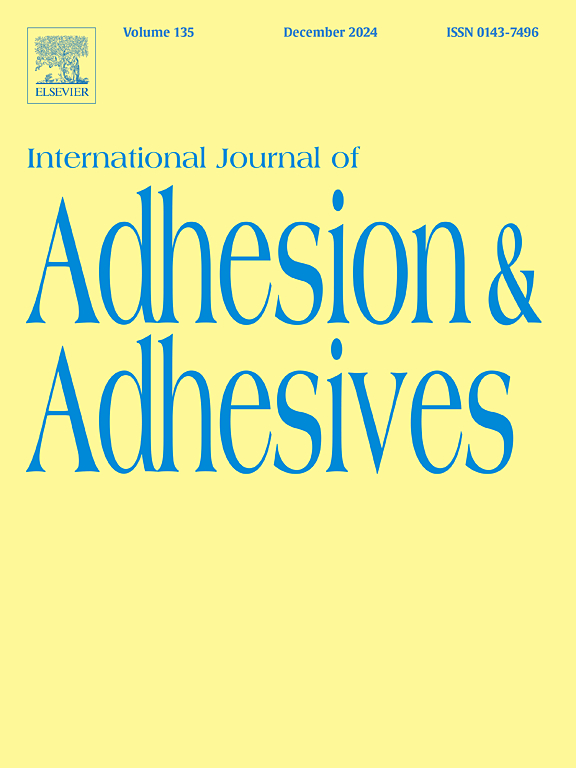Adhesive properties of universal adhesives systems containing zinc oxide and copper nanoparticles on sound dentine: A 2-year evaluation
IF 3.5
3区 材料科学
Q2 ENGINEERING, CHEMICAL
International Journal of Adhesion and Adhesives
Pub Date : 2025-04-08
DOI:10.1016/j.ijadhadh.2025.104023
引用次数: 0
Abstract
Objectives
This study evaluated the effect of adding zinc oxide and copper nanoparticles (ZnO/CuNp) to universal adhesives (UA) on resin-dentine microtensile bond strength (μTBS), nanoleakage (NL), and the presence of ZnO/CuNp within the hybrid layer at immediate time (IM) and after 2 years of water storage (2y).
Methods
ZnO/CuNp (commercial adhesive [control]; 5/0.1 and 5/0.2 wt%) were added to Prime&Bond Active (PBA) and Ambar Universal (AMB). The UAs were applied to flat dentine surfaces, followed by composite resin build-ups. These were then sectioned into resin–dentine bonded sticks. μTBS, NL and presence of ZnO/CuNp in the hybrid layer were evaluated at IM and after 2y. Data were analyzed with three-way ANOVA and Tukey's post hoc test (α = 0.05).
Results
The addition of ZnO/CuNp to UAs did not affect μTBS at IM (p > 0.05). After 2y, μTBS values were higher in the 5/0.1 and 5/0.2 wt% groups for AMB (p < 0.05), with values maintained for the PB (p > 0.05). All groups showed a decrease in μTBS over time (p < 0.05), except for the AMB-5/0.1 wt% group in etch-and-rinse mode. NL was lower in the ZnO/CuNp groups at both IM and 2y compared to control (p < 0.05). NL increased over time for all groups (p < 0.05). ZnO/CuNp remained in the hybrid layer after 2y.
Conclusions
ZnO/CuNp improves adhesive interface stability and remains effective in the hybrid layer after 2 years of water storage.
含有氧化锌和铜纳米粒子的通用胶粘剂系统在健全牙本质上的粘接性能:2年评价
目的研究氧化锌和铜纳米粒子(ZnO/CuNp)在通用胶粘剂(UA)中添加对树脂-牙本质微拉伸结合强度(μTBS)、纳米渗漏(NL)以及混合层内即时(IM)和2年后(2y)氧化锌/CuNp存在的影响。方法szno /CuNp(商用胶[对照];5/0.1和5/0.2 wt%)分别加入Prime&;Bond Active (PBA)和Ambar Universal (AMB)中。紫外吸收剂应用于牙质平面,然后是复合树脂堆积。然后将它们分割成树脂-牙本质粘合棒。μTBS、NL和ZnO/CuNp的存在分别在IM和2y后进行测定。数据分析采用三因素方差分析和Tukey事后检验(α = 0.05)。结果ZnO/CuNp的加入对μTBS无显著影响(p >;0.05)。2y后,5/0.1和5/0.2 wt%的AMB组的μTBS值较高(p <;0.05), PB值保持不变(p >;0.05)。所有组的μTBS均随时间下降(p <;0.05),除了在蚀刻和漂洗模式下的AMB-5/0.1 wt%组。与对照组相比,ZnO/CuNp组在IM和2y时的NL均较低(p <;0.05)。所有组的NL均随时间增加(p <;0.05)。2y后ZnO/CuNp仍留在杂化层中。结论szno /CuNp提高了粘接界面的稳定性,并在2年的保水后在杂化层中保持有效。
本文章由计算机程序翻译,如有差异,请以英文原文为准。
求助全文
约1分钟内获得全文
求助全文
来源期刊

International Journal of Adhesion and Adhesives
工程技术-材料科学:综合
CiteScore
6.90
自引率
8.80%
发文量
200
审稿时长
8.3 months
期刊介绍:
The International Journal of Adhesion and Adhesives draws together the many aspects of the science and technology of adhesive materials, from fundamental research and development work to industrial applications. Subject areas covered include: interfacial interactions, surface chemistry, methods of testing, accumulation of test data on physical and mechanical properties, environmental effects, new adhesive materials, sealants, design of bonded joints, and manufacturing technology.
 求助内容:
求助内容: 应助结果提醒方式:
应助结果提醒方式:


